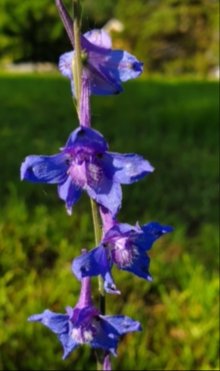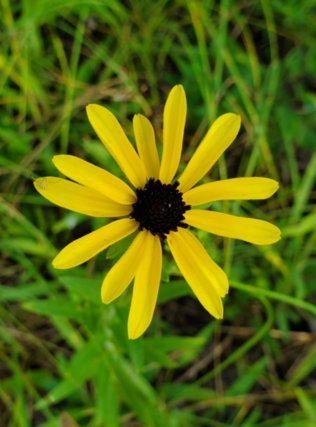The Carolina Larkspur, the Killdeer, and the discovery of our glade
Story & Photos by Edie Starbuck
Our house was built in 1979 in an area that had been pasture. There was one owner prior to us moving in in 1988 and we could tell that the previous owners cared no more about lawn grass than we do – no fertilizer, no seeding, just keep it mowed. And mow it we did for another twenty-five years.
Now, there is an area of particularly thin soil in our yard where once when we had not kept up with mowing, I had noticed some pretty blue flowers blooming, but at the time I was uneducated about native plants and we just kept mowing. In 2016, 2017, 2018, my thoughts on plants evolved when I joined the Missouri Master Naturalists and then the Missouri Native Plant Society. I began to take more notice of all of the wild plants around me and realized the area of thin soil in our yard harbored quite a few native plants and only a scant number of nonnatives. I became interested in seeing that area grow un-mowed, but of course, I needed to convince my husband, particularly since the area is right in the middle of our front yard!
Fate intervened when a pair of killdeer made a nest in the middle of the area. My husband, who had not entirely bought into the idea of leaving an area of the yard un-mowed because I thought there were several interesting native plants there, very willingly left the area un-mowed for the killdeer.

Then in May, the Carolina larkspur, Delphinium carolinium, began to bloom! Several stems of this lovely deep blue larkspur growing to three feet in height are present in our yard. This got the attention of both of us! Since this time, the area that is not mowed has enlarged, but not beyond my ability to hand weed to remove a few nonnatives. I enjoy walking through the area nearly every day to see what new is blooming and I continue to identify plants I haven’t seen before.
Currently, there are more than seventy plants on my list of discoveries there. Though we still usually refer to it as our “un-mowed area”, I feel that we could probably refer to it as our glade because of the thin soil and the presence of several glade-loving plants, including Rudbeckia missouriensis, Missouri orange coneflower or Missouri black-eyed Susan.

Though I’m planning on a number of years passing before we ever sell the house because we can no longer take care of it or the glade, I sometimes wonder what will become of the glade. I’m hoping that our rough-looking lawn will only attract people who are not interested in nonnative grass and I can convince them that the glade is worth mowing around. If not, then I’m hoping that a couple of killdeer make a nest and stay long enough for the new owners to fall in love with the plants there, as I have.